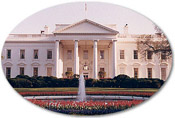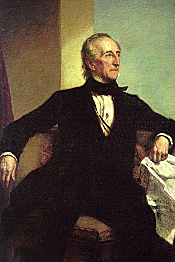

JOHN TYLER
Biography
When President William Henry Harrison died in office on April 4, 1841, John Tyler became the first Vice President in American history to be elevated to the presidency. He came to power at a time when the new Whig Party was badly divided. The Northern Whigs, led by Senator Henry Clay of Kentucky, favored government aid to industry, a national bank, and government funds to build roads and canals. The Southern Whigs, headed by John Tyler, believed that government was best when it governed least. Many of them, like Tyler himself, were ex-Southern Democrats who had joined the Whigs in the 1830's because of their dislike of Democratic President Andrew Jackson. The Southern Whigs favored states' rights. They had more in common with the Southern Democrats, led by South Carolina Senator John C. Calhoun, than with the Northern Whigs
.His Political Career
Except for the years 1834 to 1844, when he called himself a Whig, John Tyler was a life-long Democrat. He was elected to almost every office open to a professional politician. From 1811 to 1816 and again from 1823 to 1825 he sat in the Virginia House of Delegates. From 1816 to 1821 he served in the United States House of Representatives. He was elected governor of Virginia in 1825, but he resigned in 1827 to enter the United States Senate. There he remained until 1836. In that year he resigned his Senate seat and left the Democratic Party rather than support policies of President Andrew Jackson that he believed unconstitutional. In 1836 he ran for vice president. Defeated, he returned to the Virginia House of Delegates in 1838. He was serving as Speaker of that body when the Whigs nominated him to run as vice president with William Henry Harrison of Ohio in the exciting “Tippecanoe and Tyler too” campaign of 1840. “Tippecanoe” was a nickname for Harrison, who had won the Battle of Tippecanoe against the Shawnee Indians in 1811.
Tyler's nomination was designed to balance the ticket. The Whigs thought it a shrewd idea to put a man who was a former Southern Democrat on their ballot to draw votes in the South. They did this knowing that Tyler’s political principles were not supported by Harrison, Clay, or the Northern Whigs. Thus, when Harrison suddenly died in office, the surprised Whigs were faced with a man in the White House who opposed much of their program. Clay quickly set out to drive Tyler from the party and from the presidency. He wanted the presidency for himself in 1844.
His Administration
Tyler had scarcely settled into the White House when Henry Clay decided to drive him out of it. The Kentucky senator produced two bills to re-establish the Bank of the United States. He knew Tyler would veto these bills, and he was right. During the political warfare that followed the bank bill vetoes, Clay persuaded all of Tyler’s Cabinet, except Webster, to resign in a body. He hoped this would cause the President to quit his office in panic and disgust. But Tyler calmly appointed a new Cabinet and stood firm. Then Clay had Tyler thrown out of the Whig Party. By October, 1841, the Tyler administration was a shambles.
After that, Tyler worked more closely with the Southern Democrats. With their aid, he was able to accomplish much in the field of foreign policy. In 1842 he and Secretary of State Daniel Webster negotiated the Webster-Ashburton Treaty with Britain, which settled the boundary between Maine and Canada. More important, in 1845, Tyler brought about the annexation of Texas to the United States. He considered this his most important contribution. It made up for all the defeats and disappointments he suffered in the presidency.
Annexation of Texas
Tyler wanted Americans to remember him for some great accomplishment. Because of his break with Clay, he knew that the divided Whig Party could get little done in domestic matters. For this reason he turned to the annexation of Texas, which was then an independent republic and previously had been part of Mexico. Many Southern Whigs and Democrats around the President wanted annexation because it would bring another slave state into the Union. Tyler did not want it for this reason. Instead, he saw annexation as an opportunity to expand American trade into the Southwest and as a chance to bring most of the world's cotton production under the American flag. But above all he wanted the annexation of Texas to rescue the historical prestige of his sagging administration.
Between 1843 and 1844 Tyler and his new secretary of state, Abel P. Upshur (1791-1844), secretly worked out an annexation treaty with the Republic of Texas. Unfortunately Upshur was killed in an accident in February, 1844. John C. Calhoun then became secretary of state. Calhoun unwisely linked Texas annexation to the expansion of slavery. This was a political blunder in an election year. The treaty quickly became involved in sectional politics, and the Senate turned it down. Many senators wanted to wait and see how the people felt on the annexation issue in the coming elections of 1844.
Meanwhile, Tyler had formed a small third party with the slogan “Tyler and Texas.” He knew he himself had no chance of re-election in 1844. He created his party only to force the wavering Democrats to support annexation. He agreed to withdraw from the race if James K. Polk and the Democrats would pledge annexation in their platform and stick to their promise. When Polk agreed to this bargain, Tyler quit the campaign. He threw his support to Polk, who defeated Clay by a narrow margin. The President-elect then urged the Democrats in Congress to support Tyler's Texas treaty. Congress finally approved the treaty in February, 1845, and an overjoyed Tyler signed it just before he left office. Throughout the whole annexation debate Tyler showed great political skill and patience.
Years of Retirement
From 1845 to 1861, Tyler and his second wife, (Letitia Christian Tyler, the President's first wife, died in the White House in September, 1842), Julia Gardiner, spent peaceful years at Sherwood Forest, his plantation on the James River below Richmond, Virginia (when they were married in New York City on June 26, 1844, Tyler became the first president to be wed while in office). Seven children were born to them there. Lively dinners and dances and fox hunts were held. About 70 slaves worked the corn and wheat fields of the sprawling estate. Tyler was an excellent farmer. He experimented with new fertilizers, and the harvests were good. But Julia always managed to spend more money then the plantation brought in. The Tylers were in constant financial trouble as a result of large expenditures for entertainment, clothes, and travel.
Sherwood Forest seemed a model Southern plantation. No whips or lashes were ever used on the slaves there. The slaves appeared happy and contented, and there were no runaways. But all this was deceiving. When the Union Army overran the proud estate in 1864, the slaves quickly and gladly departed. Before they left, they sacked and plundered the main house.
Secession and Civil War
As the Civil War approached, John Tyler was on the side of moderation. He thought that the problems of slavery and the expansion of slavery into the territories could be solved by compromise rather than by a bloody civil war. When South Carolina seceded in December, 1860, and the Confederate States of America was formed on February 8, 1861, Tyler was saddened.
Although he was now 70, tired, and sick, he agreed to leave retirement to serve as president of the Peace Conference, which met in Washington, D.C., on February 4, 1861. He soon saw, however, that this last attempt to preserve the Union was doomed to failure. At this point he returned to Richmond and became an outspoken secessionist. His vain hope was that if Virginia joined the Confederacy, the border states would follow its lead. This would make the enlarged Confederacy so strong that the federal government would not dare risk a war. Thus peace would be preserved, and Virginia would not become a battleground. Tyler wanted Virginia's secession to preserve the peace; not peace to preserve the Confederacy. He was willing to sacrifice the Union to prevent bloodshed.
Following Virginia's secession on April 17, 1861, Tyler was elected to the House of Representatives of the Confederate Provisional Congress. This was the last of his many political offices. He was serving in this post when he suffered a stroke and died in a Richmond hotel on January 18, 1862. He was 71. He died in debt and in doubt, branded a traitor by the very government he had once headed.








